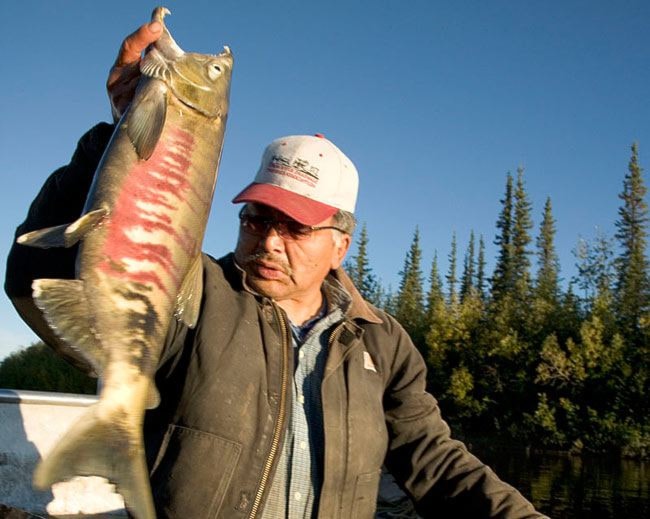Not only are the chum salmon late, but fewer are showing up.
The fewest ever, in fact, according to sonar counters near the mouth of the Yukon River.
Only 173,500 chum have shown up, less than 35 per cent of the yearly average of 487,000.
“If this holds up, it’s not looking to be a very good return this year,” said Sandy Johnston, lead scientist for the Yukon branch of the Department of Fisheries and Oceans.
All along the river, test fisheries have been coming up short.
Just outside Fairbanks, the Rampart Rapids fishwheel would normally have seen 90,500 chum.
This year, only 3,700 chum have been counted.
Chum salmon are often referred to as dog salmon, based on the fish’s primary use as sled-dog food.
“Five to 10 per cent of my fish go for human food, and the rest go for dog food,” said Sebastian Jones, a Dawson-based commercial fisher.
A “dedicated” chum fisher, Jones will typically bring in 2,000 to 3,000 chum salmon.
More and more, however, chinook-starved fishers have been putting chum on their dinner plates.
Chum are a great “alternate” to chinook, said Jones.
Less oily, chum fare better in the smokehouse - which makes for better jerky, he said.
“There’s a lot of people who have been fishing chum, especially in light of previous years where the chinook numbers have been so depressed,” said James MacDonald, director of fish and wildlife for the Tr’ondek Hwech’in.
“This year, that’s just not the case,” said MacDonald.
Knee-deep in chinook this year, Dawsonites are once again chucking their chum to the dogs.
Only four years ago, chum had flocked to the Yukon River in record numbers.
In 2005, more than 1.3 million fish made the upriver journey.
Surprisingly, this year’s chum are the offspring of that record-breaking year.
“Overcrowding” in 2005 likely caused the brood to plummet, said Johnston.
“Traditional science would say that because of that record return, you wouldn’t expect many to come back,” he said.
Chum are often overshadowed by their more glamorous chinook cousins.
Sport fishers will go for sockeye, coho, spring and chinook salmon - but never chum.
They’re almost half the size, for one thing.
And pound for pound, the less-oily chum also fetch less at fish markets.
At the supermarket, chum can often be seen packaged in low-priced tins labelled “keta salmon.”
“It’s a glamour thing as much as anything else, plus the commercial value of (chinook),” said Jones.
With chinook returns projected to remain low, chum will increasingly be supplementing the freezers of Yukon River fishers.
“It’s a perfectly good salmon, it doesn’t taste bad,” said Jones.
In Alaska, subsistence fishers were counting on chum to supplement their lowest-ever chinook harvest.
Chinook-poor Alaskan villagers now find themselves lacking for food, and cash for heating oil.
Many are already bracing for another humanitarian crisis this winter.
“If we have a low fall chum run it’s going to be the nail in the coffin for a bunch of us,” said Andy Bassich, a resident of Eagle, Alaska, in comments to the Anchorage Daily News.
Contact Tristin Hopper at
tristinh@yukon-news.com
